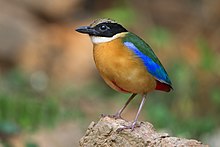Pittas
| Pittas | ||||||||||||
|---|---|---|---|---|---|---|---|---|---|---|---|---|

Bengal pitta ( Pitta brachyura ) |
||||||||||||
| Systematics | ||||||||||||
|
||||||||||||
| Scientific name | ||||||||||||
| Pittidae | ||||||||||||
| Swainson , 1831 |
The Pittas (Pittidae) are a family in the order of the passerine birds (Passeriformes). The birds live in Central Africa, South and Southeast Asia, and Australia. Most of the species are found in Southeast Asia.
features
They are small, short-tailed and thrush-like forest floor dwellers with colorful plumage. The head is relatively large, the neck short, the body stocky and the wings short and rounded at the tip. The different species are 15 to 28 centimeters long. Among the 31 species, some show a pronounced sexual dimorphism , while in other species both sexes are colored the same. Many species of Pitta are very brightly colored, especially blue, green, red and yellow are common. The bright colors are mainly on the belly or are not visible when the wings are folded, so that birds do not attract predators too much.
Way of life
Pittas live solitary hidden in undergrowth rich rainforests , bamboo thickets, bush landscapes and mangroves . They prefer to be close to flowing water and go up to 2500 meters in the mountains. During the day they usually stay on the ground, the night they spend high in the trees. Even in danger, they usually flee on foot first. The birds mark their territory with a song that consists of polysyllabic whistles, but also grunting and whimpering tones. They fly into the trees to sing. They look for their food on the ground and feed mainly on worms, spiders, insects, seeds and fruits, but also on small lizards and frogs. Some Pitta species make long migrations during the night.
Reproduction
Pittas are monogamous. They breed in the tropics at the end of the rainy season when their main food, insects, are particularly numerous. In more temperate zones, they reproduce in summer. In some species a courtship dance has been observed, in which the male leaps into the air from a branch near the ground and presents his colored belly. Pittas build large, dome-shaped nests camouflaged with moss and leaves with a side entrance between roots, fallen branches or low bushes at heights of one to two meters. These contain two to seven shiny white or isabel-colored eggs with reddish to purple-colored speckles and spots. Both sexes take part in raising the young. After 14 to 18 days, the initially naked cubs hatch, which leave the nest after 15 to 17 days, but the parents continue to feed them for about ten days.
Danger
The natural enemies of the pittas are birds of prey , small cats and snakes . Today Pittas are threatened by the deforestation of the rainforests, forest fires and the destruction of their other habitats. They are caught by humans as food or for cage. The IUCN classifies the golden throated pitta of Thailand and southern Myanmar as critically endangered. Schneider pitta , red back pitta , black back pitta , blue bellied pitta , cook pitta , chestnut back pitta , nymph pitta and black face pitta are considered endangered, giant pitta , sulapitta , garnet pitta and mangrove pitta as potentially endangered.
Systematics
Pittas belong within the passerine birds (Passeriformes) to the subordination of the screeching birds (Tyranni). Their closest relatives are the lobed pittas (Philepittidae) and the broad throat (Eurylaimidae).




-
Erythropitta Bonaparte, 1854
- Red-headed pitta ( Erythropitta arcuata )
- Philippines blue breasted pitta ( Erythropitta erythrogaster )
- Louisiade blue breasted pitta ( Erythropitta meeki )
- Garnet pitta ( Erythropitta granatina )
- Kochpitta ( Erythropitta kochi )
- Chestnut back pitta ( Erythropitta venusta )
- Black and red pitta ( Erythropitta ussheri )
-
Hydrornis Blyth, 1843
- Red-backed pitta ( Hydrornis baudii )
- Giant pitta ( Hydrornis caeruleus )
- Blue pitta ( Hydrornis cyaneus )
- Grünscheitelpitta ( Hydrornis ellioti )
- Javabindenpitta ( Hydrornis guajanus )
- Gold throated pitta ( Hydrornis gurneyi )
- Malay band pitta ( Hydrornis irena )
- Blue- naped pitta ( Hydrornis nipalensis )
- Brown- headed pitta ( Hydrornis oatesi )
- Ear pitta ( Hydrornis phayrei ( Blyth , 1862))
- Schneiderpitta ( Hydrornis schneideri )
- Borneobindenpitta ( Hydrornis schwaneri )
- Blue rump pitta ( Hydrornis soror )
-
Pitta Vieillot , 1816
- Black- faced pitta ( Pitta anerythra )
- Angolapitta ( Pitta angolensis )
- Bengal pitta ( Pitta brachyura Linnaeus 1766)
- Ornamental Pitta ( Pitta elegans )
- Rainbow Pitta ( Pitta iris )
- White breasted pitta ( Pitta maxima )
- Great blue-winged pitta or mangrove pitta ( Pitta megarhyncha )
- Little blue-winged pitta ( Pitta moluccensis )
- Nymphenpitta ( Pitta nympha Temminck & Schlegel 1850)
- Green breasted pitta ( Pittareichenowi )
- Cap pitta ( Pitta sordida )
- Blue-bellied Pitta ( Pitta steerii )
- Black- backed Pitta ( Pitta superba )
- Noise pitta ( Pitta versicolor )
literature
- Gottfried Mauersberger: Urania animal kingdom, birds. Urania-Verlag, 1991, ISBN 3-332-00491-3 .
- Theo Pagel , Bernd Marcordes: Exotic soft-eaters. Eugen Ulmer Verlag, Stuttgart 2011, ISBN 978-3-8001-5192-9 .
- Christopher M. Perrins : The Great Encyclopedia of Birds. From the English, Orbis-Verlag, Munich 1996, ISBN 3-572-00810-7 .
- Chris Gooddie: The Jewel Hunter. Princeton University Press, Old Basing Hampshire 2010, ISBN 978-1-903657-16-4 .
Web links
- The Animal Diversity Web: Family Pittidae
- IOC World Bird List: NZ wrens, broadbills & pittas
Footnotes
- ^ BirdLife International 2005. Pitta gurneyi . In: IUCN 2007 Red List of Threatened Species. www.iucnredlist.org . Downloaded on December 13, 2007.
- ↑ Great blue-winged pitta ( Pitta megarhyncha ) at Avibase; Retrieved December 27, 2013.
- ↑ Little blue-winged pitta ( Pitta moluccensis ) at Avibase; Retrieved December 27, 2013.